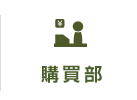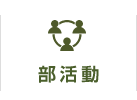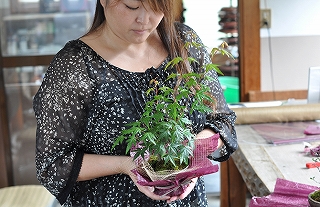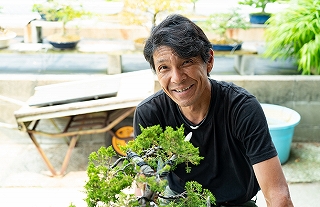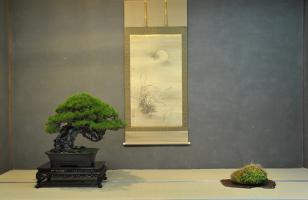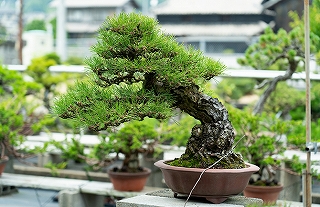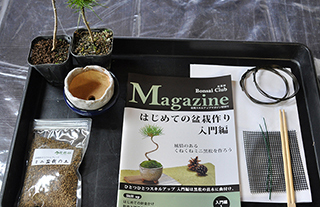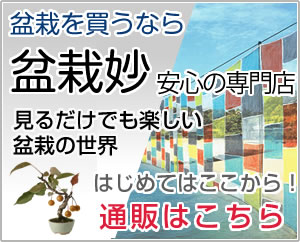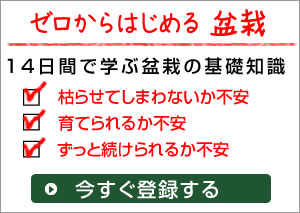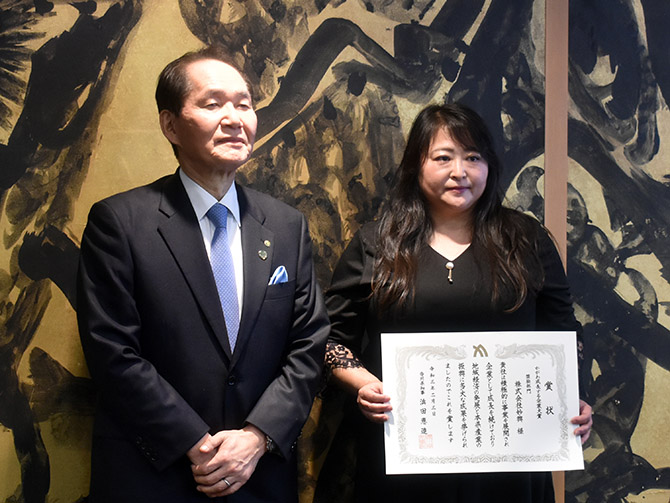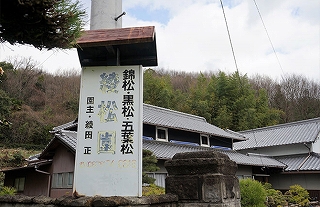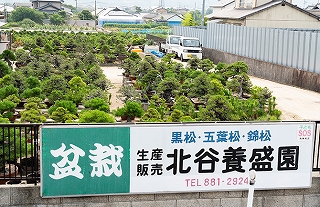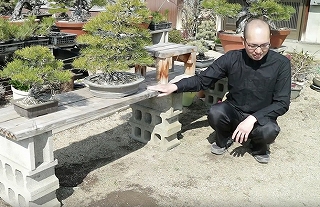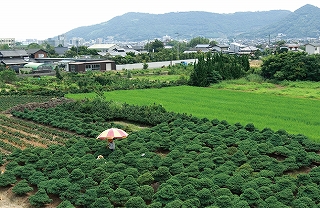About Takamatsu Bonsai
- Seven Things That Bonsai Buyers Want to Know Before Coming to Takamatsu to Make Their Purchases

- 高村雅子
- 盆栽妙 店長
- 更新日:2022/8/25
- 投稿日:2022/8/25
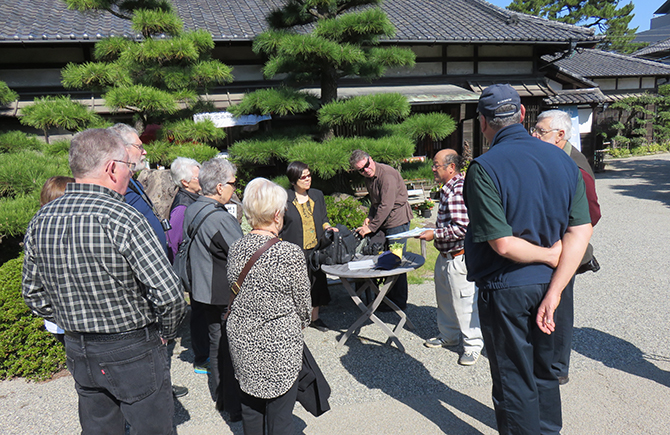
1. About Takamatsu Bonsai
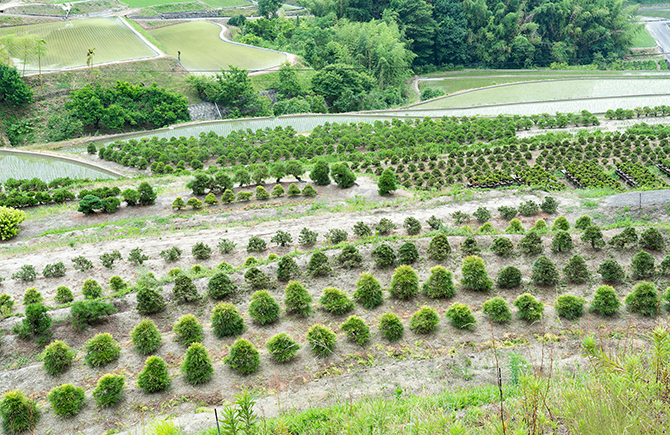
Located in the western part of the city of Takamatsu in Kagawa Prefecture, the districts of Kinashi and Kokubunji are home to rare pine fields that are good for growing Japanese black pine, Nishiki-matsu, and Japanese white pine, and there are many bonsai gardens around.
Kagawa Prefecture is said to be the largest producer of pine bonsai in Japan, and the Takamatsu bonsai has 80% share of all domestic sales.
About Takamatsu bonsai it is said that its origins go as far as 200 years ago from the times around the Bunka era (1804-1818) in the Edo period and that it came from the practice of planting trees which were growing nearby in pots and selling them, however, the full-scale bonsai production started after the Meiji period. Let's see in detail how the districts of Kinashi and Kokubunji established the tradition of Takamatsu Bonsai.
Kinashi bonsai which started in the Edo period
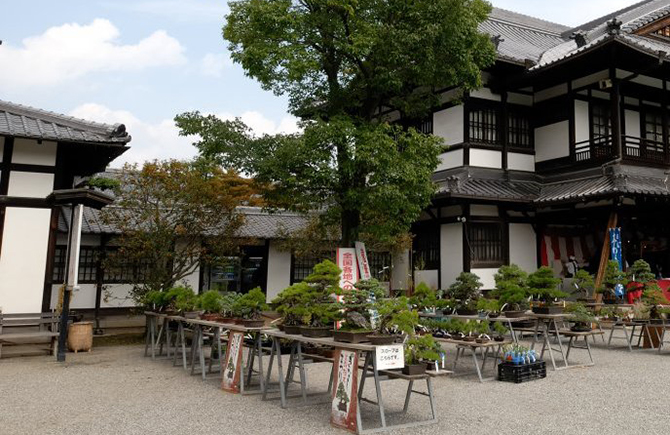
According to the inscription on the monument in the square at the Kinashi Tree and Bonsai Center in Kinashi, Takamatsu, the Kinashi bonsai began in the Bunka era of the Edo period. It is said that the trigger was in the fact that worshipers to the Kotohiragu Shrine were buying the pines that grew in fields and mountains as souvenirs after they were dug out and arranged in pots by the locals.
As for bonsai cultivation, its origin owes to the emergence of Shusuke Takahashi. Takahashi was a master of grafting and passed his technology on to everyone. At the same time, Taisaku Kitayama was growing seedlings of conifer trees and earned huge profits.
When Jinzaburo Kinashi who was taught by Takahashi imported apple seedlings from the America and planted them in the forests and fields, the number of apple growers increased and orders for seedlings flooded in, fruit tree seedling production had spread onto farmers in the area, and this production technology later became useful for bonsai cultivation.
Around 1887, Benkichi Yamane of Kinashi district and Shinzo Tada of Sato district started to arrange wild-growing pine trees which were collected in the mountains into bonsai.
The Nishiki-matsu Bonsai and Kokubunji as its birthplace
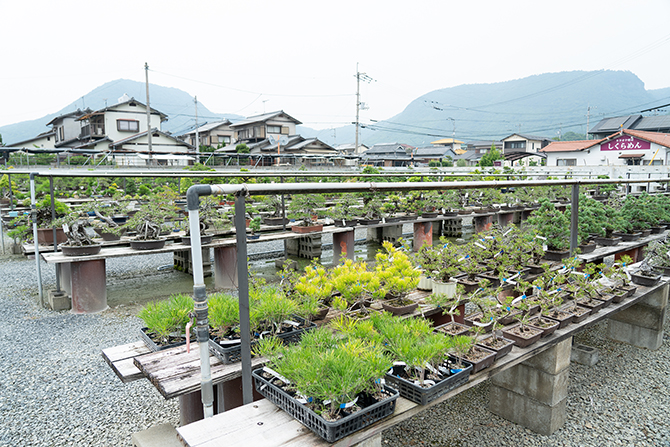
On the other hand, Kiichi Suezawa from Kokubunji district, who produced wild forest saplings and trees for planting, held training sessions together with 10 other people and invited Shinzo Tada to Kinashi. Along with mastering bonsai production techniques, they also began manufacturing bonsai.
About 1892, there was a person taught by Mr. Suezawa who found and harvested a Nishiki-matsu with very good characteristics in the mountains, so Mr. Suezawa bought it at a high price and started culturing it. Based on the principles of heritability, Suezawa took a good pine twig (a branch used for cutting and grafting), noticed that a large number of Nishiki-matsu pines could be produced from it by grafting and continued to enthusiastically work on that technique.
At last in 1894, he succeeded in grafting and made mass production possible, which had greatly transformed the original making of bonsai using Japanese black pine into making of bonsai which adopted grafted Nishiki-matsu pine.
As for the further production of trees in Kinashi and Kokubunji, they have been produced mainly for bonsai.
Ichizou Kitatani and Hiraki Matsuzo of Kinashi developed a bonsai pine arrangement technique using wires at the end of the Meiji period, and Suezawa developed a pine trunk torsion technique in the middle of Taisho period. In Kinashi, Rikichi Kitatani and Souhachi Hanazawa introduced Japanese white pine from the city of Takadazuka and started bonsai production with it.
Postwar reconstruction and becoming the country's leading producer
As the above techniques spread in Kinashi and Kokubunji, the bonsai production expanded.
Production of bonsai plants, which was on the rise, also ended as the life in the whole region stopped due to the Second World War, and the pine trees in the bonsai fields were turned into firewood as crops production was given priority.
Bonsai production had completely stopped for a while but was resurrected through grafting of pine trees a few of which were left in the fields after the war. With the postwar economic growth, bonsai became more popular and demand for it increased at once.
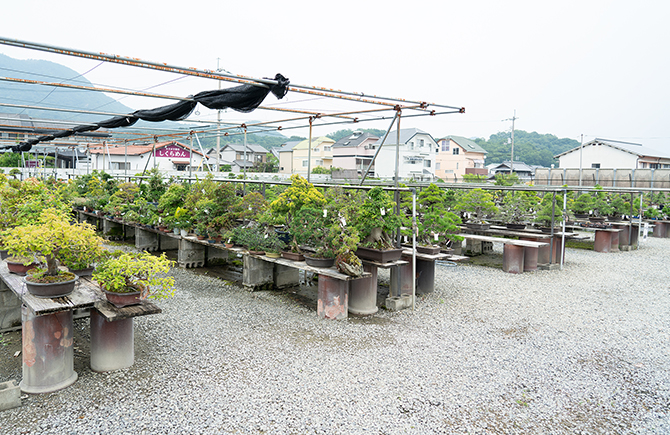
Due to such conditions as granite sandy loam soils with good drainage, low amounts of rain, long hours of sunshine and the climate of the Seto Inland Sea coastline, it is possible to produce distinctive bonsai trees which do not exist in other production areas.
Having continued to develop and improve the techniques of pruning and grafting that were being polished through the practices of cultivation, etc., the area grew as the country's top pine bonsai production area.
Pine bonsai from Kagawa Prefecture grown in well-drained soils is notoriously beautiful and has a reputation for being “resistant to root rotting and damage”.
Pine bonsai from Kagawa Prefecture are displayed and sold locally at Bonsai centers across the prefecture as well as on the Internet to bonsai lovers throughout the country.
From Japan's number one pine bonsai production area to number one in the world
The trigger for major attention to Takamatsu Bonsai from around the world was the 11th Asia-Pacific Bonsai and Suiseki Convention and Exhibition (ASPAC) held in the city of Takamatsu in 2011. It was held for the first time in Japan and attracted bonsai fans gathering from over 40 countries including those in Asia, the West and others.
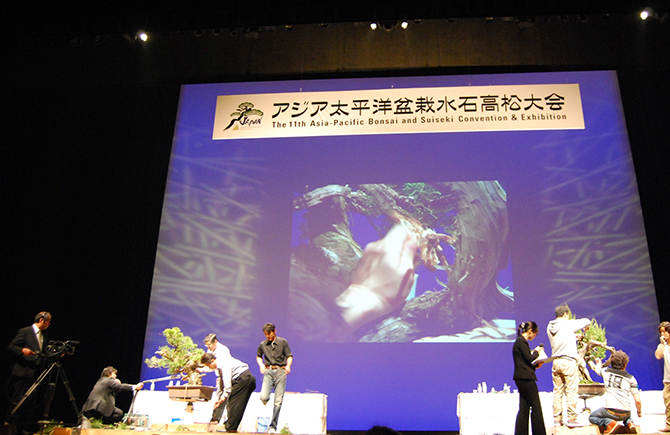
In addition, a number of bonsai enthusiasts from around the world visited the Takamatsu Bonsai Convention in 2014, which established recognition for the name of the place as the Mecca of bonsai.
Nowadays, from just being Japans number one area for pine bonsai production it has become well-known as the world number one producer, with buyers coming from Asia, Europe, and the United States.
The present situation with bonsai exports
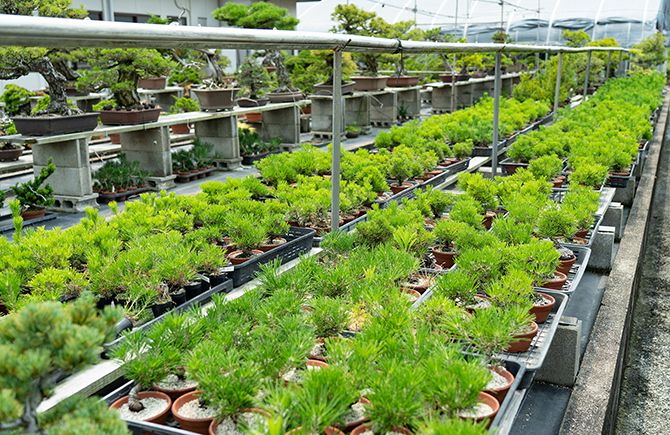
In Kagawa Prefecture bonsai are mainly grown in the city of Takamatsu with cultivation areas covering 12 hectares and their shipping volumes are currently worth over 200 million yen.
Due to changes in lifestyle and structure of dwellings, the domestic bonsai market has the tendency of shrinking, and there are problems such as decline in the number of farmers who produce bonsai as the population is aging.
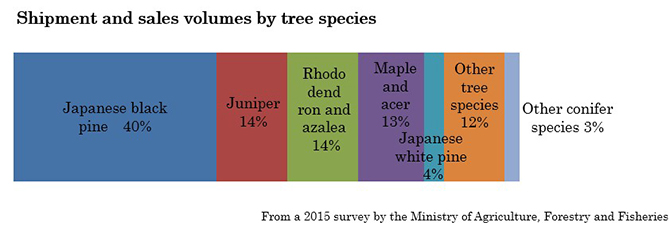
On the other hand, bonsai has been recognized overseas so much as the word "BONSAI" has even been included in dictionaries, and is being highly regarded as Japan’s traditional culture, which has been gaining popularity, while the export amounts of bonsai and trees produced in the prefecture have been increasing year by year.
As for bonsai exports, the volume is almost evenly split between Saitama Prefecture, which is the major production area in the Kanto region and Kagawa Prefecture.
In terms of shipments and sales by tree species, it is 40% for Japanese black pine, next is 14% each for juniper, rhododendron and azalea, and 13% for maple and acer.
Destinations for Takamatsu bonsai exports have plant quarantine conditions to be complied with and speaking of volumes - Taiwan has the largest share, accounting for about 80% of the total, followed by the United States, China, and the EU.
When exporting bonsai, quarantine conditions differ depending on the tree species and the destination country, so it is necessary to respond differently to each case.
For example, in the EU, the import of pine trees is prohibited, but exceptions are made for Japanese white pine if it meets conditions with cypresses and junipers being also allowed.
During the 11th Asia-Pacific Bonsai and Suiseki Convention and Exhibition (ASPAC) held in Takamatsu in 2011 the international awareness about Takamatsu Bonsai also considerably increased, and international bonsai enthusiasts and buyers from such regions as Asia, the U.S., the Western and Eastern Europe, South America, etc. started coming to visit bonsai gardens in the districts of Kinashi and Kokubunji one after another.
In order to establish the brand of Takamatsu Bonsai overseas and expand its exports, export-related associations were established at bonsai gardens in Kinashi and Kokubunji districts, and they are currently actively developing overseas sales channels.
2. Representative tree species of Takamatsu bonsai
1) Kuromatsu (Japanese black pine)
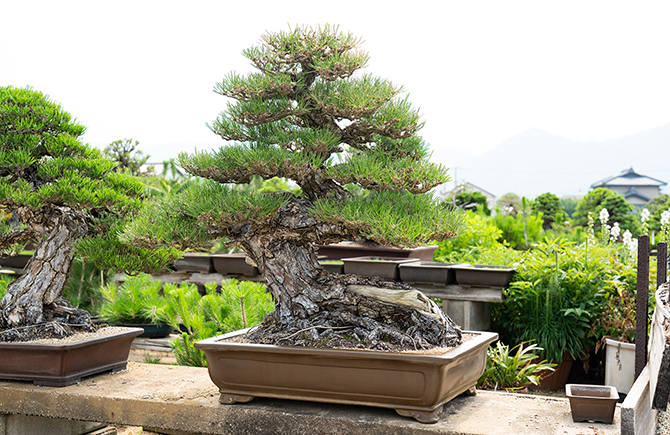
Characterized by long and rigid needled compared to Japanese white pine. It is a representative tree species in bonsai that shares popularity with Japanese white pine in masculine bonsai designs.
With its low amounts of rain and the climate with long sunshine hours, Takamatsu has become the production center for the world’s most representative Japanese black pine trees with many excellent products created.
Most of the Japanese black pines that have won competitions were those used in Takamatsu bonsai. In Takamatsu, there are many craftsmen who put their hearts into bonsai in which Japanese black pine trees are used.
2) Japanese white pine
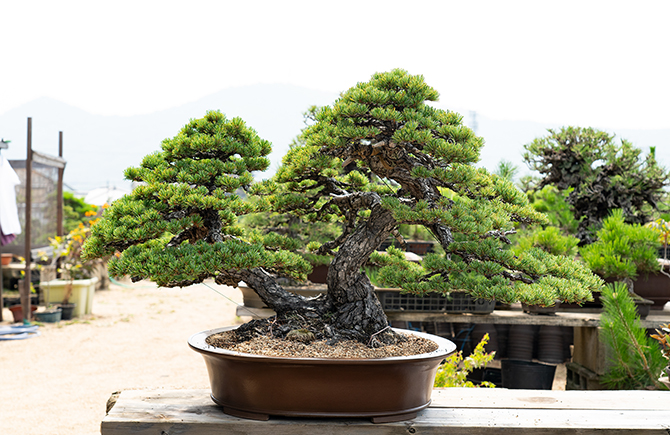
There are many types of it from small to large, including Japanese white pine trees which are over 100 years old, Japanese white pine trees raised from seedlings, and those which were grafted. It is very popular as a bonsai tree and is often seen in Takamatsu because it is strong and grows fast when grafted on a Japanese black pine tree.
3) Nishiki-matsu
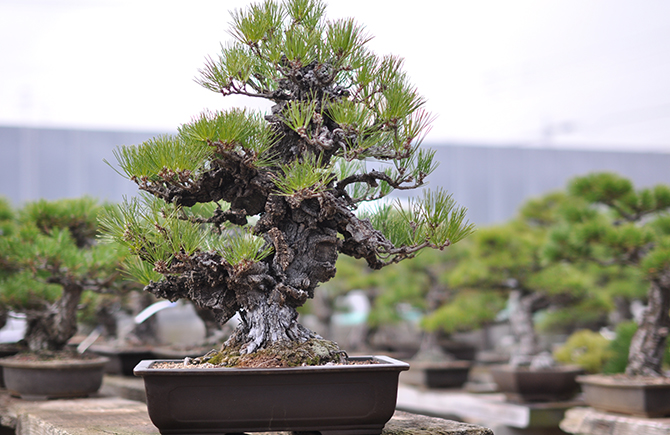
Its bark forms a cork layer and gets thick cracks which look like those on a turtle shell. It is a mutation of Japanese black pine.
Nishiki-matsu is a variant of Japanese black pine, and its birthplace is in Takamatsu. It is characterized by rough and wavy bark covering the trunk, which creates the feeling of an old tree.
It can be said that this breed was created thanks to the skills and techniques of producers from Takamatsu who had perfectly mastered cultivating normal Japanese black pine trees.
3. Introduction of bonsai gardens
4. Bonsai craftsman
Hiramatsu Koji
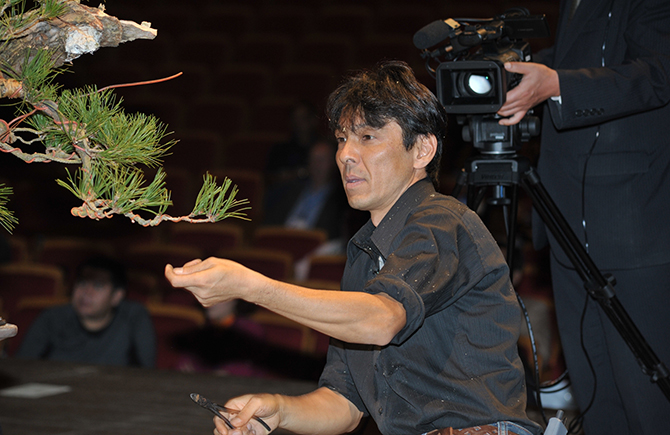
Born on December 23, 1967
The 4th generation owner of a 150-year-old bonsai garden "Hiramatsu Shun Sho-en".
He has been brushing up his skills under the guidance of his father, Kuniaki, and became the 4th generation owner of "Hiramatsu Shun Sho-en", one of the finest gardens in Takamatsu.
At the 11th Asia-Pacific Bonsai and Suiseki Convention and Exhibition (ASPAC) held in 2011 in Takamatsu, he conducted demonstrations on bonsai adaptations which attracted enthusiastic Bonsai fans from around the world.
Since then, he has been uninterruptedly receiving requests for demonstrations and workshops at overseas exhibitions, for which he has been traveling abroad for about two months each year.
Using his outstanding techniques, starting from his university days he has been active around the world as "Mr. Hiramatsu of the world" in countries of Asia, France, Italy, Eastern Europe and South America.
With the motto of "enjoying improvisation with a tree which you get to meet for a limited time and balancing the strength and beauty of nature with the artificial beauty created in a short moment", he has been challenging himself to new ways of demonstrating bonsai.
He has also been teaching bonsai at a local elementary school for over 10 years now.
"My mission is to fully protect the genuine bonsai tradition and hand it down to future generations"
5. The Climate of Kagawa Prefecture
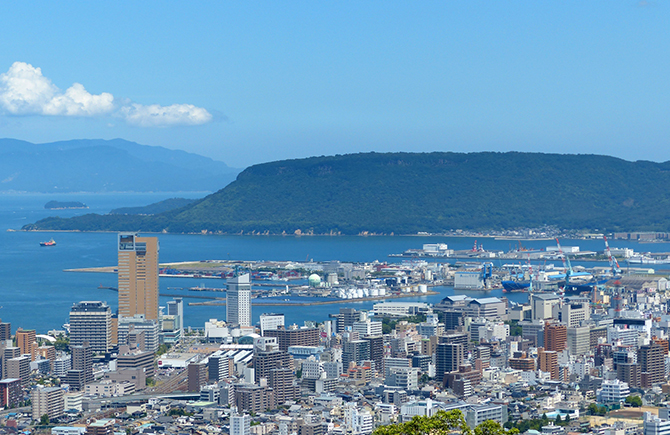
Kagawa Prefecture is the smallest prefecture in Japan with the area of 1876 sq.km. (For comparison, London occupies 1572 sq.km, New York: 783 sq. km and Tokyo: 622 sq.km).
Located in the western part of Japan, along with three prefectures of Ehime, Kochi and Tokushima, it makes up the island of Shikoku, one of the islands away from Honshu on which Tokyo is located and is connected to Okayama Prefecture by the Seto Ohashi bridge.
Facing the Seto Inland Sea, which is an inner sea, it is comprised of the main part located on the island of Shikoku and of 112 islands (24 of which are inhabited) such as Shodoshima and Naoshima, which host international art festivals such as the Setouchi International Art Festival taking place every three years.
Located in the northeastern part of Shikoku, it has a long half-moon shape stretching from the west to east with the Sanuki Mountains in the south and the Sanuki plain dotted with 14,000 ponds in the north.
The climate of the Seto Inland Sea is characterized as being relatively warm throughout the year with low precipitation and long daylight hours.
It is a scenic place blessed with beautiful nature such as the sea and mountains and warm climate attracting many visitors from Japan and abroad. The total number of visiting foreign guests recorded its highest growth rate nationwide in the recent years.
Takamatsu City, the gateway to Shikoku
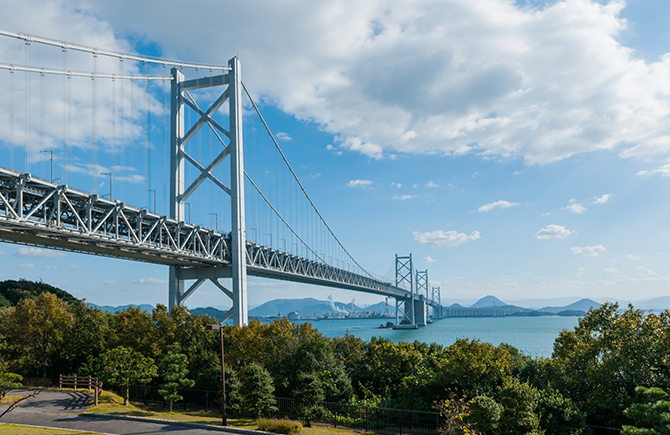
Takamatsu City, located in the center of Kagawa Prefecture, is the prefectural capital. It is a gateway to Shikoku and there are many government institutions and offices of national companies, as it is one of central locations of politics and economy in Shikoku.
Due to its characteristics of having developed as a port town, there is an urban area facing the sea on the north side, the Sanuki Mountains in the south and islands such as Megijima and Ogijima scattered in the sea creating beautiful views.
It is a well-balanced city where you can enjoy urban conveniences together with natural environment.
Kinashi district
It is an area that extends to the foot of Mt. Katsuga (altitude 364 m) facing the northwestern part of the city of Takamatsu and the Seto Inland Sea. The whole area is a part of the Takamatsu Plain, and there are many ponds used as reservoirs in this area.
It has long been known as the birthplace of the legend of Momotaro, and it has the Kumano Gongen Momotaro Shrine, and the "Momotaro Festival" is held here at the end of March of every year.
It is home a square-front circular-back burial mound of 60.5m in length which is said to have been built in the 5th century and is a prefecture designated historic site, the ruins of a castle which used to belong to an aristocratic family of the medieval Sanuki clan and is currently the city designated historic site, the ruins of Katsuga castle near the top of Mt. Katsuga, a horizontal stone chamber tomb which is said to have been built from the end of the 6th century to the early 7th century and is considered to be large-scale even for the whole the prefecture as well as of ancient shrines and burial mounds.
The only main road in the district is Prefectural Road 33, the Takamatsu Zentsuji Line, and shops and houses are densely concentrated to the north of Kinashi Station.
Kokubunji district
Adjacent to the western part of Takamatsu City, it is a town located on basin-like terrain stretching 3.4 km east to west and 7.5 km north to south. Surrounded by rolling hills, it is dotted with large and small reservoir ponds forming idyllic rural scenery.
Since ancient times, the place has flourished as a center of politics, culture, and religion, and its Sanuki Kokubunji Temple was designated as a national special historical site and has a museum. In the museum, there are displays covering the ruins excavated during excavation surveys, the model of the temple’s Golden Pavilion, etc. which together introduce the history of Kokubunji.
Sanuki Kokubunji, which is said to have been built before 756, is the eightieth of the eighty-eight shrines of Shikoku.
The area is easy to access from Takamatsu Airport, Takamatsu Expressway, Seto Ohashi bridge, etc. using the National Road 11 which crosses the town from east to west and is famous for having been developing as a dormitory suburb outside Takamatsu City.
?
| ? | Population | Area |
| Kagawa Prefecture | Approx. 960,000 | 1877 km2 |
| Takamatsu City | Approx. 427,000 | 375.53km2 |
| Kokubunji district in Takamatsu | Approx. 24,000 | 26.25 km2 |
| Kinashi district in Takamatsu(Jurisdiction of Kinashi office of Takamatsu city hall) | Approx. 6,000 | 6.98 km2 |
6. Bonsai related events
In Kinashi and Kokubunji, large bonsai-related events are held in spring and autumn. In addition, there are many opportunities not only for bonsai enthusiasts, but for the general public to experience bonsai throughout the year at monthly tree markets held in Kinashi as well as at those held in Tamamo Park.
1)Kinashi Green Fair
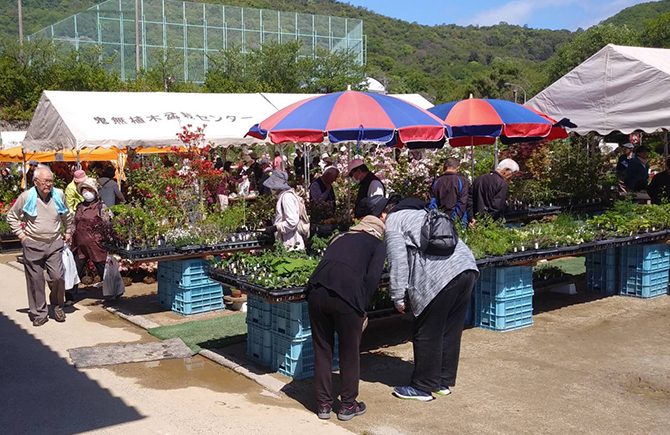
Period: late April
Location: Kagawa Prefecture Kinashi Tree and Bonsai Center
Bonsai, trees for planting, seedlings, flowers, etc. are displayed and sold by members of the Kagawa Kinashi Seedling and Bonsai Center who put great efforts into the event. Lotteries, conferences and auctions are also held.
2) Kinashi Bonsai Tree Festival
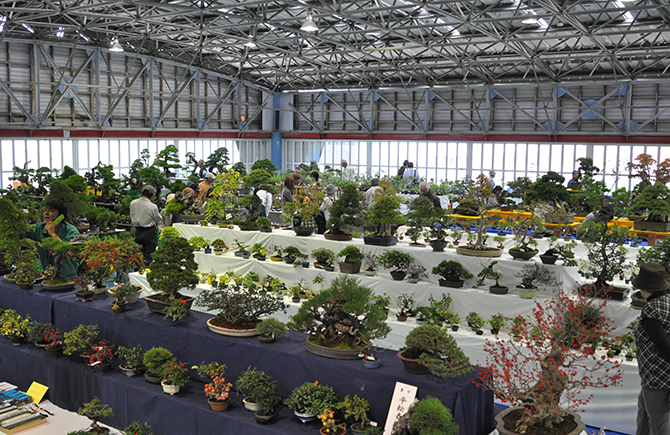
Period: late October
Location: Kagawa Prefecture Kinashi Tree and Bonsai Center
About 10,000 bonsai plants, trees, and flowers of 500 different species which are all special products of Kagawa are displayed and sold here on the spot. Special bonsai exhibitions, the wire wrapping experience, workshops by bonsai tree specialists, general horticultural consultations, auctions, etc. are held.
※ In recent years, the event is being held simultaneously with the Green Festa Kokubunji
3) Kokubunji Bonsai Center, Spring Festival (late April) / Autumn Festival (late September)
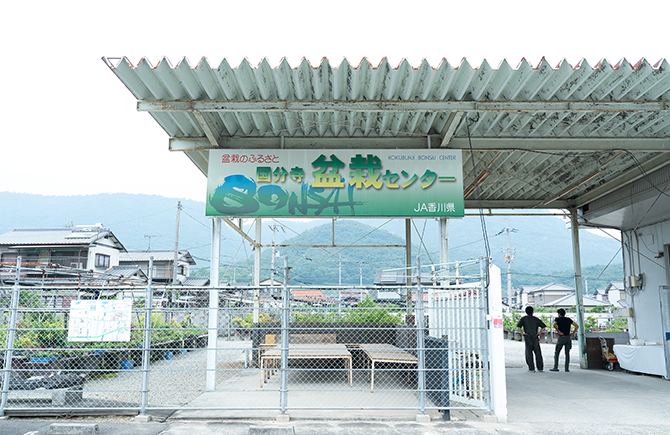
Period: Spring Festival Late April
Autumn Festival Late September
Location: Kokubunji Bonsai Center
A variety of bonsai trees, potted flowers, wildflowers, etc. are exhibited and sold. About 3,000 pots with bonsai will be shown. There are classes on making moss balls as well as auctions for bonsai created by local craftsmen.
4) Green Festa Kokubunji
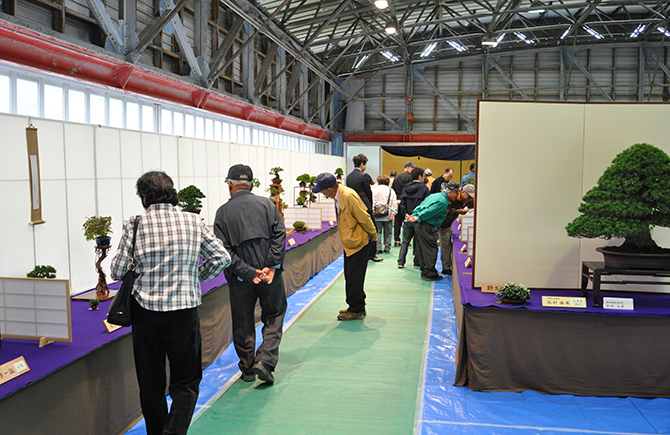
Period: late October
Location: Multipurpose Hall at Kokubunji Tachibananooka Park
Gorgeous items owned by bonsai enthusiasts from inside and outside Kagawa Prefecture and national treasure-level bonsai that have won awards at domestic bonsai exhibitions will be on display. There will be bonsai lessons, children’s portable shrine procession, bonsai auctions, mochi rice cake throwing and sales of loach (dojo) soup.
5) Kinashi district Fortnightly tree markets
Period: twice a month, 2nd and 4th Wednesday
Location: Kagawa Prefecture Kinashi Tree and Bonsai Center
Bonsai shops from around the country bring in garden trees and bonsai and hold auctions. It is basically an exchange between vendors, but anyone can participate after registering and paying the prescribed registration fee.
6) Tamamo Park "Spring Tree Market"
Period: from early March to early April
Location: Historic site of Takamatsu Castle, Tamamo Park
About 1,500 items from potted plants and flowers to pine tree bonsai and garden trees are on display and sale. Because it takes place in the castle park, you can take a walk along the ruins of the castle while enjoying the signs of the coming spring.
※ Required admission fee: adults 200 yen, children 100 yen
7. Bonsai tourism
Kagawa prefecture is the largest pine bonsai production area in Japan. It is Japan’s leading bonsai area with many spots in where you can get the feel of the history, traditions, and the present of the art of bonsai. It is also recommended that you take short trips to get in touch with bonsai by visiting various locations related to the art.
1)JA Kagawa Prefecture Kokubunji Bonsai Center
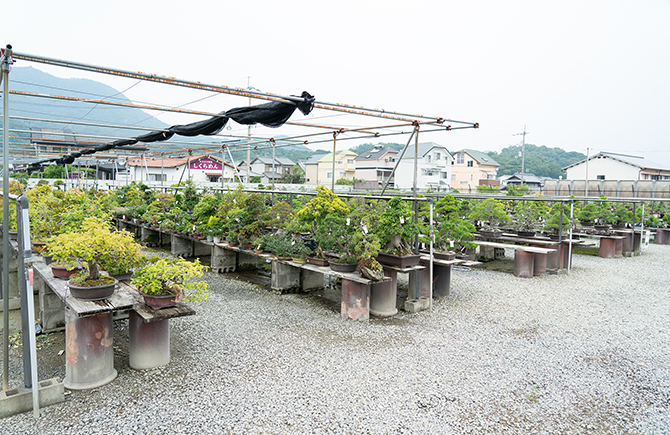
Bonsai are displayed and sold here. In addition to pine bonsai made with Japanese white pine, Japanese black pine and Nishiki-matsu, 8,000 pots are constantly on display and sale, including those made with such trees as maple, rhododendron, persimmon, etc., flower- and fruit-bearing bonsai and those with wild plants.
Address: 353-1, Kokubunji, Kokubunji-cho, Takamatsu City
Phone number: 087-874-2795
Opening hours: 8:30 to 17:00
Closed: January 1-3
Parking lot: available
2)Kagawa Prefecture Kinashi Tree and Bonsai Center
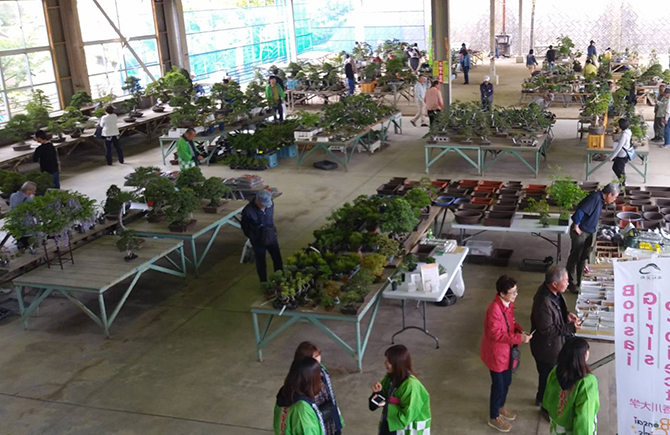
Address: 331-3, Yamaguchi, Kinashicho, Takamatsu City
Phone number: 087-882-4091
Opening hours: 9:00 to 14:00
Closed:
Parking lot: available
3) Bonsai Shrine
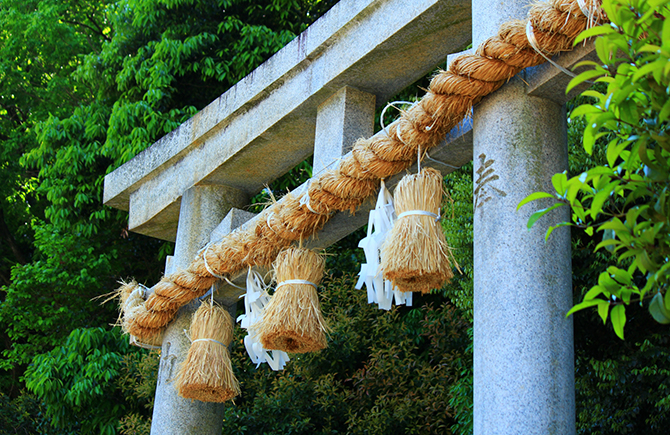
It is located at the foot of Mt. Ikariyama in Kokubunji-cho, Takamatsu City next to the Kokubunji-cho Wholesale Bonsai Plant Nursery. It is the only Shinto shrine in Japan which is dedicated to prayers for happiness to come to the homeland of bonsai and where the deities of trees and flowers are being worshiped.
Address: 3854, Nii, Kokubunji-cho, Takamatsu City
Phone number: 087-874-2795
Parking lot: available (next to Kokubunji-cho Wholesale Bonsai Plant Nursery)
4) Village Cafe “Sakuya Kobo”
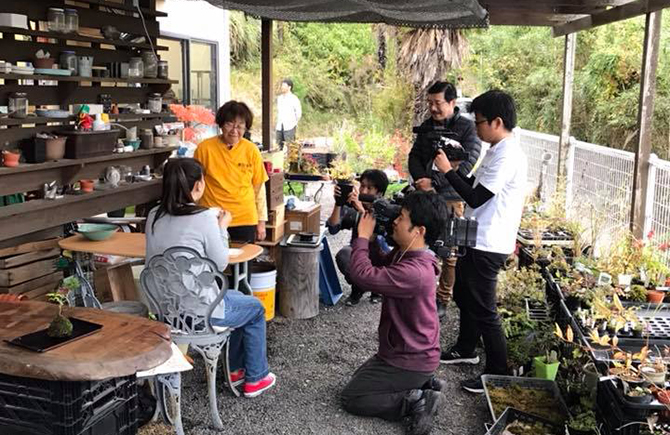
Originally called Hashimoto Shokoen, the business was cultivating bonsai in Kokubunji town in the city of Takamatsu, which is a production area for bonsai. Later switched to cultivation of wild grasses and flowers and open a village cafe. Has a variety of local menu courses tailored to each of the four seasons, such as moss ball making and gardening classes for guests.
Address: 2553-2, Nii, Kokubunji-cho, Takamatsu City, Kagawa Prefecture
Opening hours: 10:00-16:00
Phone number: 087-813-5287
Parking lot: available (10 spots)
Experience lessons: reservation required 5 days before the event (※ Fees vary depending on the contents of experience lessons)
5) Oki Olive
The company grows 1,500 olive trees in a 6.3-hectare field. It also operates a cafe and a guest house, which serve cuisine in which oil that has won the country category award at the “JOOP International Olive Oil Contest” is used.
Address: 4532, Nishiuetacho, Takamatsu City, Kagawa Prefecture
Phone number: 087-880-7346
Parking lot: available
6) Bonsai Village
In addition to introducing the history and culture of Takamatsu Bonsai, it is a base facility that holds various activities related to bonsai such as tourism and workshops. It is a space similar to a visitor center serving for promotion of exchange between Japan and abroad as well as between people from the region and outside visitors through the art of bonsai.
7) Training facility
It is a facility equipped with accommodation facilities for receiving trainees who come from across Japan and abroad to learn bonsai techniques. It is suited for various people such as those who are interested in bonsai and those who want to improve their skills, as well as for workers from bonsai production areas.
8) Ritsurin Garden
It originated in the end of the 16th century, had been being built for over 100 years and was completed in 1745. Currently designated as a national special place of scenic beauty and is the largest cultural property garden in Japan. Has about 1,400 beautiful selected pine trees. Received a 3-star rating in the Michelin Green Guide Japan.
Address: 1-20-16, Ritsurincho, Takamatsu City
Phone: 087-833-7411
Opening days: all year round
Opening times: right after sunrise to sunset
Entrance fee: general admission - adults 410 yen, children 170 yen
● Ritsurin Garden Volunteer Guides
Volunteer guides stand by next to the East Gate entrance ticket office. They are free of charge (the garden entrance fee is required) and the tour lasts about 1 to 1.5 hours. For groups, reservations are required.
Tours in English, Chinese and Korean are also available (* Reservations required).
May be unavailable depending on the situation with reservations and requested contents
Phone: 087-833-7411 (Ritsurin Garden Tourism Office)
9) Tamamo Park / Takamatsu Castle ruins
One of Japan's Three Great Water Castles. The park was built based on the ruins of Takamatsu castle which is a national historic site. The walls are connected to the Seto Inland Sea by means of a water gate. In the park, there is Hiunkaku garden, which is designated as a national scenic spot. It is also designated as an important cultural property along with Tsukimi Yagura Turret and Mizute Gate.
Address: 2-1, Tamamocho, Takamatsu City
Phone: 087-851-1521
Opening days: West Gate (March) 6:30-18:00 (April) 5:30-18:30,
East Gate (March) 8:30-17:00 (April) 7:00-18:00
Entrance fee: adults 200 yen, children 100 yen
この記事を書いた人

- 高村雅子
- 盆栽妙の店長 盆栽家。三重県鈴鹿の田舎生まれ。大学進学を機に大阪に出て卒業後は秘書として企業で働く。結婚して退職、子育てに奮闘。子供も大きくなり、自分の時間が持てるようになったので、かねてより大好きだった植物をもっと勉強するべく、盆栽の世界へ踏み入ることに。同郷の盆栽職人 太田重幸に師事し、盆栽の奥深さを修行した後、自宅で教室を開業。2007年にインターネット盆栽販売店 盆栽妙をオープンし、盆栽メルマガ登録数日本一に。盆栽はじめるサポートに日々奮闘中。
関連記事


